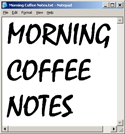
|
|||||||||||||||||||||||||||||||||||||||||||||||||||||
|
How to display a tweet? -- Part II Last night the wind howled in the hills of Berkeley. It could have been the sound track for the opening scene of a horror movie about global warming. It got me up at 1:30AM with a burning question. What's the best way to display a tweet? It's not a joke, it actually happened. So I posed the question with a few examples, and a great discussion ensued, and I think we arrived at an excellent answer. 1. I had assumed that a mini-icon would work the best, but Alexander Horre asked why not use a bit of text, so if someone makes it bigger, the link symbol would grow along with everything else. Good point, and I think that's the way to go. (Many others said the same thing, Alexander was just the first.) 2. Chuck Shotton and Steven Levy both argued for making the links work just like HTML links, but I didn't see how, until Chuck suggested that we use wiki notation, and this is very workable, and if that formatting is detected any software should recognize it and display it accordingly. Example. 3. What software? Well lots of apps display text that came from Twitter. Facebook does, as does FriendFeed and many others. Of course I wouldn't have asked this question if I weren't too. Prior art search: How to display a tweet? You know what a tweet is and how they're displayed in Twitter. Pretend you're a time traveler from 2003 and someone told you that a primary software interface was going to include bare naked urls, would you have believed it? I wouldn't. I still don't accept that it's the best way to display a tweet. These days lots of software displays them, not just Twitter. And they all have the same problem -- how to display the urls. I haven't seen a lot of approaches. I'd like to generate some, to gather different non-raw-url approaches. Here's an example: Where are the Users at the User Generated Content Expo? We don't shorten urls just to conserve space within the 140-character limit, shortening urls also makes our writing more legible. For that application we could go the full distance and collapse the url down to an 11-by-11 icon. If so, what should the icon be? Here are some examples of vast collections of free mini icons. I'm assuming the best approach is to shrink the url to an icon and store it to the right of the text but if you knew the big ugly url was going to shrink to an icon, you might start putting the urls in the middle of sentences in ur tweets. Maybe a mini-icon isn't the best way to go, maybe there's another way altogether to neaten up tweets and make them more readable? (And yes, I know some people will say the way Twitter does it now is the best possible way, please assume we're all considering that possibility as well). I'm interested to know what people think. I just got on the inbound BART from the Berkeley station, and I have wifi through the Cradlepoint but I don't have a net connection because we're underground. However, in a few minutes, between Ashby and MacArthur, we will emerge and my router should be able to establish a connection. This probably will happen a lot faster than if I had used the software on my laptop to connect cause it's pretty clunky and slow and sometimes takes two or three times to connect. The Cradlepoint seems to do this much better. And you'll know it's working because you're reading this. |
"The protoblogger." - NY Times.
"The father of modern-day content distribution." - PC World.
One of BusinessWeek's 25 Most Influential People on the Web. "Helped popularize blogging, podcasting and RSS." - Time.
"The father of blogging and RSS." - BBC.
"RSS was born in 1997 out of the confluence of Dave Winer's 'Really Simple Syndication' technology, used to push out blog updates, and Netscape's 'Rich Site Summary', which allowed users to create custom Netscape home pages with regularly updated data flows." - Tim O'Reilly.
My most recent trivia on Twitter. On This Day In: 2008 2007 2006 2005 2004 2003 2002 2001 2000 1999 1998. |
||||||||||||||||||||||||||||||||||||||||||||||||||||
|
© Copyright 1997-2009 Dave Winer. Previous / Next |
|||||||||||||||||||||||||||||||||||||||||||||||||||||


